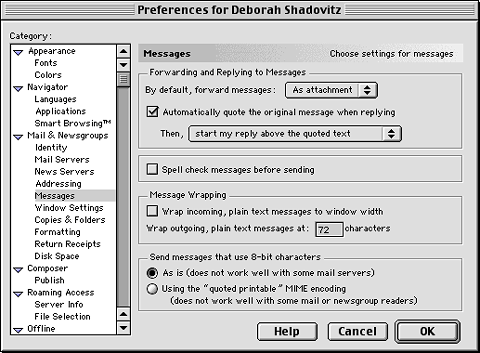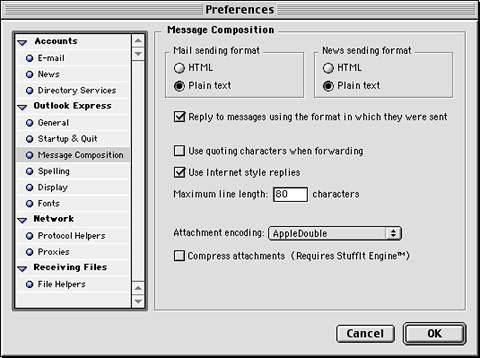|
||||
E-mail efficiency Part 1Written and published October 6, 1999 While e-mail is not quite the art form that a good, handwritten letter can be, there is a bit of art in e-mail. No, I'm too much the artist to try to prove that point, but e-mail messages are written communication and should be treated as such. Well-written, that is. Just because you can dash off an e-mail in a moment doesn't mean you shouldn't take a few extra moments to write it correctly. And just because you don't pay postage to send an e-mail doesn't mean you should deluge people with unwanted messages. Over the next two or three weeks we'll look at e-mail. The inspiration for this topic came in a request from reader Julian Y. Koh, who wrote to me after the first bookmark column requesting that I mention how to properly state a URL in an e-mail. Julian's wisdom is here, mingled with lessons I've learned from various e-mail lists. Everything in quotes are Julian's words. In other places I've paraphrased him.) Lingering and looney linesHave you ever wondered why some people's e-mail messages are full of long lines while other messages have short lines? In e-mail programs this is a user-set preference. At other times, like when you write to a company via a form on its site, the Web page designer pre-sets the line length. The variances of line lengths can make for ugly e-mails. You know what I'm talking about: You reply to a message, or you get sent a copy, and the lines alternate between 75 characters on a line followed by short, five-character lines, or something similar. A good way to see if your line length is wreaking havoc on messages is to reply to several incoming messages with yourself as the recipient. If everyone had the same line lengths, or if text wrapped fluidly like in a word processor, e-mail could look a lot prettier. But that's not the case. If you're using a real e-mail program you can adjust your line lengths. The preference may state "columns," but you can replace the word "columns" for "characters" in your mind.
I've opted to set my lines at 80 characters, which I understand is the maximum acceptable length. I figure it's not too long for me to read, and this way I don't tend to be the cause of odd text wrapping when I quote text. (Of course, I also use TextSOAP or another cleaner app to clean the text so it's sent out looking nice.) I'm not the expert on line lengths, so, if you're reading this and have better advice or background, please let me know and I'll pass it on.
Passing on a URLWhen you send someone a URL to look at, take the time to insert two extra keystrokes to enclose the URL in brackets (<>). These brackets are not just decoration. They are actually instructions. As Julian explains it: When a URL is long and spans more than 1 line, a line break gets inserted when the e-mail is sent out. By enclosing the URL in these brackets, this line break doesn't interfere with the URL. When the recipient clicks on the hyperlinked URL in his/her e-mail client (assuming it's supported), the line breaks will get removed and the URL is passed to the Web browser properly. At times, you'll come across a program that adds the brackets automatically. However, neither Netscape Communicator nor Microsoft Internet Explorer adds them when you select "Copy Link to Clipboard" from a pop-up menu that appears when you click and hold on a link in a Web page. Perhaps Apple should set the ILFs to add these brackets when you drag the IFL into a document. (I'll pass that suggestion on to my pals over there.) Additionally, type out the entire URL. For example, write <http://www.maccentral.com> rather than <www.maccentral.com>. That way, if the reader's e-mail program is up to modern standards, the reader receives a clickable link. Check the timeMake sure the date and time on your Mac is correct. Having the wrong date on all of your documents might not bother you (although it wouldn't exactly be efficient), but when you send out e-mail with the wrong date you're sure to bug an awful lot of people. E-mail is often sorted by date so the recipient can see the newest messages at the top. If your date is old your message may not even be noticed. If your date/clock is ahead, your message will remain at the top of the list, rather than allowing true new messages to be seen. It's easy to check your Mac's date/time/time zone settings in the Date and Time control panel. Signature savvy"Bajillion-line signatures" are not cool -- and not going to earn you respect among the Net-savvy. Julian writes: "The accepted Net standard (as per the Good Net-Keeping Seal of Approval) is four lines of 80 characters apiece (called the McQuary limit), and you should delimit your signature from the rest of your message with a "-- " (2 dashes followed by a space)." To see for yourself and learn more you can visit the GNKSA page. Next weekIn the next weeks we'll look at things like fancy (HMTL) formatting vs. plain e-mail; how to reply to or forward a message properly; how to handle lists; attachments; and other aspects of e-mail. There is plenty to cover. If you have a pet peeve about bad Netiquette and you want to make sure I'll cover it or pass on your advice, drop me a line. I may not be able to reply to every message, but I'll read and sort them all for use. And let me know if it's OK to use your name. |
||||

